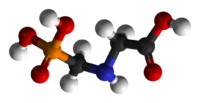
Photo from wikipedia
Glyphosate is the organophosphate pesticide most widely used in the world. Recent studies correlate exposure to glyphosate and the emergence of neurodevelopmental disorders. Therefore, it was objective to propose a… Click to show full abstract
Glyphosate is the organophosphate pesticide most widely used in the world. Recent studies correlate exposure to glyphosate and the emergence of neurodevelopmental disorders. Therefore, it was objective to propose a rat model of perinatal exposure to glyphosate‐based herbicides (GBH) to study associated neurodevelopmental disorders. Behavioral aspects and brain pathways were assessed in the prepubertal phase. For this, maternal treatment occurred throughout the entire gestation period (from GD0) until weaning on postnatal day 22 (PND 22). Control group received oral gavage with 5 mL/kg of saline per day and GBH group received oral gavage with 50 mg/kg of GBH per day (n = 10 per group). Maternal behavior was evaluated in PND 2–6. Offspring were evaluated for quantification of ultrasonic vocalizations (PND 5); homing behavior test (PND 13); and hole board, social play behavior, open field, and object recognition tests (PND 28–32). Prefrontal cortex and hippocampus of the offspring were processed to evaluate oxidative stress. Maternal exposure to GBH impaired early social communication, olfactory discrimination, social play behavior, and the exploration of objects, in addition to increasing repetitive and stereotyped movements. GBH also increased oxidative stress. Therefore, perinatal GBH exposure induced behavioral and oxidative stress impairments in rats associated with neurodevelopmental disorders. The manifestations found in the offspring are in accordance with symptoms of autism spectrum disorder.
Journal Title: International Journal of Developmental Neuroscience
Year Published: 2022
Link to full text (if available)
Share on Social Media: Sign Up to like & get
recommendations!